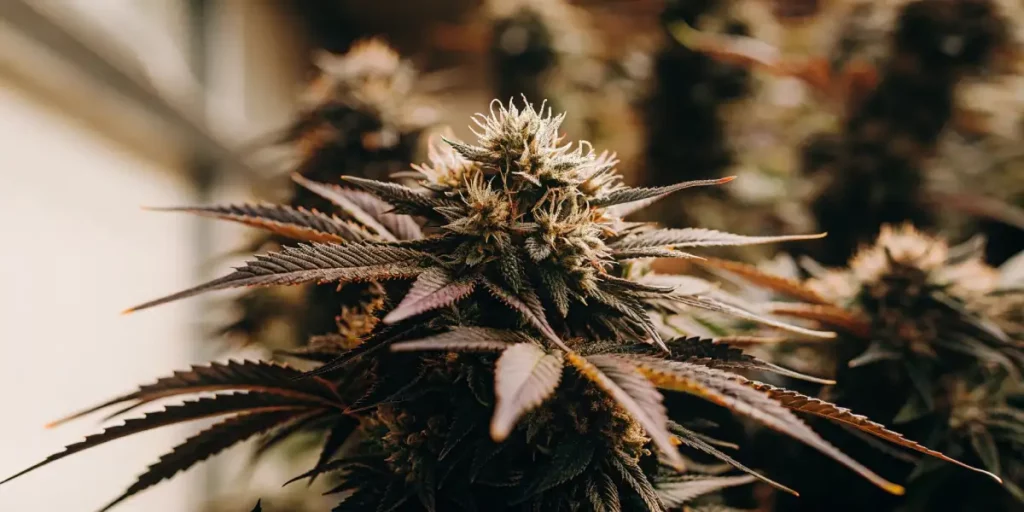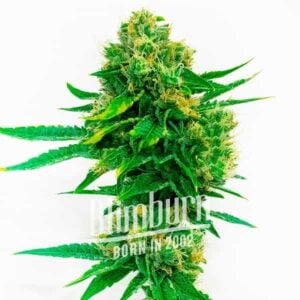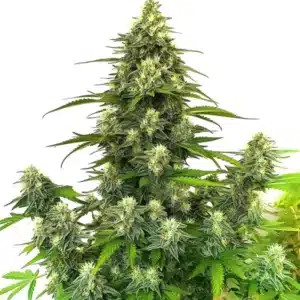Grape Ape Autoflowering Description
Grape Ape Auto is a top-tier cannabis strain, beloved for its balanced effects and high yields. This Autoflowering variety delivers the best traits of its lineage, combining the potent Grape Ape strain with Autoflowering OG Kush. Known for its impressive THC levels of 21% to 25%, this strain is a favorite for both recreational and medicinal users seeking a deeply relaxing, yet creatively stimulating experience.
Recommended Strains
Grape Ape Autoflower
 THC: 21% - 25%
THC: 21% - 25% Type of seed: Autoflowering
Type of seed: Autoflowering Phenotype: Mostly Indica
Phenotype: Mostly Indica Day to flower: 10 - 12 weeks
Day to flower: 10 - 12 weeks
The buds produced by Grape Ape Autoflowering are dense and resinous, boasting deep purple hues that contrast beautifully with its thick trichome coverage. The strain’s terpene profile is equally remarkable, with flavors of berry, fruity, and grape dominating every hit. These terpenes not only provide a delightful smoking experience but also contribute to its strong effects.
Perfect for daytime use, this strain energizes while calming the body. Whether you’re a medical user seeking relief from insomnia, arthritis, or chronic pain, or a recreational user wanting to spark creativity, this strain caters to a wide range of needs.
Promos & Deals
Environmental Requirements for Growing Grape Ape Autoflowering
To grow this strain successfully, you must create the right environment that allows it to flourish. Grape Ape Autoflowering thrives in both indoor and outdoor setups, making it a versatile choice for growers of all skill levels. This strain performs well in warm, temperate climates where daytime temperatures hover around 70-80°F (21-27°C). At night, temperatures should be slightly lower but not below 60°F (15°C).
Humidity levels need to be carefully monitored during the entire grow. In the vegetative stage, a relative humidity (RH) of 60% is ideal, while in flowering, reducing the RH to 40%-50% will help avoid mold and mildew development on the buds. For growers working indoors, maintaining these conditions with proper airflow and ventilation is essential for a healthy crop.
When growing outdoors, the strain performs best in sunny, dry climates. However, with its sturdy nature, Grape Ape Auto is resilient and adaptable, making it suitable for outdoor cultivation even in regions with fluctuating weather patterns. If growing in a greenhouse, ensure the structure has proper ventilation to prevent excess humidity and overheating.
Setting Up The Growing Cannabis Space
Indoor Cannabis Cultivation
When cultivating Grape Ape Autoflowering indoors, setting up a functional grow space is critical for achieving maximum yields. A grow tent is ideal, allowing you to control the environment while managing light, temperature, and humidity. Ensure your grow tent or room is equipped with reflective walls to enhance light distribution.
For lighting, high-quality LED grow lights are recommended, especially during the vegetative and flowering stages. During the vegetative phase, maintain an 18-20 hour light schedule. Once the plants enter flowering, switch to a 12-hour light and 12-hour dark cycle to encourage proper bud development.
The growing medium should be well-draining, whether you choose soil or a hydroponic system. Ensure that the pH levels of the medium stay between 6.0-6.5 for optimal nutrient uptake. Maintaining airflow with fans and ensuring an exhaust system with a carbon filter will also help prevent heat buildup and control odors.
Outdoor Cannabis Cultivation
If growing Grape Ape Autoflowering outdoors, choose a spot with plenty of sunlight. This strain grows well in large containers that allow proper root development, and using fabric pots can help improve drainage and air circulation around the root zone. Outdoor growers should prepare for the strain’s height, which can reach up to 4.92 feet (1.5 meters), making it necessary to use stakes or trellises to support its branches, especially as the buds become heavy during flowering.
Ensure the soil is rich in organic matter and well-draining. If growing in nutrient-poor soils, supplementing with high-quality cannabis nutrients throughout the grow cycle will support plant health and yield.

Propagation and Germination of Grape Ape Autoflowering
Proper germination is key to a successful grow. Start by sourcing high-quality Grape Ape Autoflowering seeds from reputable breeders. Begin the germination process by soaking the seeds in water for 24 hours, then transfer them to a damp paper towel until they develop a taproot. Alternatively, you can plant them directly into the growing medium after soaking.
Maintain a temperature range of 70-85°F (21-29°C) during germination, and keep the seeds in a dark, moist environment. After the seeds sprout and produce a taproot, transfer them to your preferred growing medium. Ensure that the medium is light and well-draining to avoid waterlogging and root rot.
Once the seedlings have emerged, provide indirect light for the first few days before gradually increasing the light intensity. After the first set of true leaves appear, the seedlings can be transferred to larger pots or into your outdoor garden.
Vegetative Phase of Grape Ape Autoflowering
During the vegetative phase, Grape Ape Autoflowering plants will focus on developing their structure. Providing a consistent light schedule of 18-20 hours of light per day is crucial for fast and healthy growth. The plants will grow tall and wide, so giving them enough space to spread out is important, particularly indoors.
Nutrition during this phase should be nitrogen-rich to support robust leaf and stem development. Choose cannabis-specific fertilizers and follow the manufacturer’s feeding schedule. Watering should be done only when the top inch of the soil feels dry to avoid overwatering.
Training techniques like low-stress training (LST) or topping can be used to shape the plant’s growth and improve light exposure to lower branches. This will help create a more even canopy and boost the overall yield.
Flowering Phase of Grape Ape Autoflowering
Once Grape Ape Autoflowering enters the flowering phase, the focus shifts to bud production. The light schedule should be reduced to 12 hours of light and 12 hours of darkness for optimal flowering. Buds will begin to form within the first two weeks of flowering and will become denser as time goes on.
During this phase, switch to bloom nutrients with higher phosphorus and potassium content to encourage bud development. Keep an eye on the plant’s water and nutrient needs, as overfeeding during flowering can result in nutrient burn. The flowering time for this strain is around 10-12 weeks, depending on growing conditions.
Lower the humidity to 40-50% to avoid mold and bud rot. The temperature should also be slightly cooler, around 65-75°F (18-24°C), to promote resin production and preserve terpene content. Supporting the branches with stakes or trellises will prevent them from bending under the weight of the buds.
Cannabis Fertilization and Nutrition
Nutrient management is essential for the success of your Grape Ape Autoflowering plants. During the vegetative stage, focus on nitrogen-heavy fertilizers to promote healthy leaf growth. As the plants transition into flowering, shift to bloom-specific nutrients that are high in phosphorus and potassium.
Make sure to flush the plants with clean water during the last two weeks of flowering to remove any residual salts from the growing medium. This will improve the flavor and smoothness of the final product.
Monitoring pH levels is equally important. For soil grows, maintain a pH range of 6.0-6.5, while hydroponic systems should aim for a pH between 5.5 and 6.0. If the pH is off, nutrient absorption can be hindered, leading to deficiencies.
Pest And Disease Control for Cannabis Growing
Even though Grape Ape Autoflowering is a hardy strain, pests and diseases can still pose a threat. Regular inspection of the plants can help catch problems early. Common pests like spider mites, aphids, and thrips can be controlled using organic insecticides or by introducing beneficial insects such as ladybugs.
Prevent mold and mildew by ensuring proper air circulation in your grow space. Reducing humidity levels during flowering is key to avoiding bud rot. Additionally, ensure that your plants are spaced well apart to prevent excessive moisture build-up.
Quarantine any new plants before adding them to your grow room to avoid the risk of introducing pests or diseases into your setup.
Harvesting and Curing Grape Ape Autoflowering
Harvest Grape Ape Seeds when the trichomes have reached their peak maturity. Use a magnifying glass or a microscope to check the trichomes. When they are mostly cloudy with some turning amber, it’s time to harvest.
Cut the plants at the base and hang them upside down in a cool, dark, and well-ventilated space. Keep the temperature around 60-70°F (15-21°C) and the humidity between 50-60%. Drying usually takes 7-14 days, depending on the environment.
Once dry, trim the buds and place them in airtight glass jars for curing. Open the jars daily for the first week to release excess moisture. Proper curing will take between 2-4 weeks for optimal flavor, potency, and smoothness of the final product. During curing, aim for a temperature of 60-70°F (15-21°C) with humidity levels at 58-62% to avoid mold development.

Is Grape Ape Autoflowering Indica or Sativa?
Grape Ape Autoflowering is predominantly Indica, thanks to its lineage combining Grape Ape with Autoflowering OG Kush. As a result, it exhibits the classic characteristics of an Indica-dominant hybrid. The plant itself remains short and stocky, making it ideal for discreet indoor grows or for outdoor growers with limited space.
When consumed, this strain offers the soothing and body-relaxing effects typical of Indicas, while still delivering a burst of creative energy. The balanced nature of this strain makes it suitable for both recreational and medicinal users. The high THC content, which can reach up to 25%, ensures powerful effects that kick in quickly, making it a top choice for those seeking a potent, well-rounded experience.
Advantages
Grape Ape Auto offers several advantages for cultivators, making it a popular choice among both novice and experienced growers. Here are some of the key benefits:
- Short flowering time of just 10-12 weeks, allowing for quicker harvests compared to many photoperiod strains.
- High THC content, reaching up to 25%, which guarantees a potent and long-lasting high.
- Resilience to pests and diseases, thanks to its hardy genetics derived from Grape Ape and Autoflowering OG Kush.
- Compact growth structure, making it ideal for indoor cultivation or small outdoor spaces.
- Impressive yields, especially for an Autoflowering strain, with up to 1.5 meters of plant height producing substantial buds.
- Easy to grow, with this strain being well-suited for beginner growers thanks to its forgiving nature.
Disadvantages
While Grape Ape Autoflowering is generally a great strain to grow, there are a few challenges to consider:
- Like many Autofloweringflowers, this strain has a shorter vegetative phase, which can limit the time available for training and maximizing yields.
- Due to its potent aroma, especially during flowering, growers will need to implement odor control methods, such as carbon filters, in indoor setups.
- It requires regular monitoring of temperature and humidity to avoid mold and mildew during the flowering phase.
Why Buy Grape Ape Autoflowering Seeds
There are several reasons why this strain is worth adding to your collection. Whether you’re a novice grower or an expert looking for a fast, potent strain, this Autofloweringflower delivers on all fronts. Here’s why you should consider buying this strain:
- High THC Levels: With THC content reaching up to 25%, this strain provides a powerful and long-lasting effect that can satisfy even the most seasoned users.
- Flavors and Aromas: The strain boasts a delightful combination of berry, fruity, and grape flavors, making it a favorite for those who appreciate aromatic and flavorful cannabis.
- Medical Benefits: Ideal for users seeking relief from chronic pain, insomnia, or arthritis, Grape Ape Autoflowering is a go-to for medicinal purposes.
- Easy Growing Experience: Beginners will love this strain’s low-maintenance nature, while more advanced growers can experiment with training techniques to enhance yield.
- Resilient Genetics: Thanks to its Autoflowering nature and robust lineage, this strain is adaptable to different growing environments, offering flexibility and ease of cultivation.
Common Problems When Growing Grape Ape Autoflowering
While this strain is relatively easy to grow, some challenges may arise during cultivation. Here are a few common issues that growers may encounter:
- Overfeeding: Autofloweringflowers are generally more sensitive to nutrients than photoperiod strains, and this strain is no exception. Be careful not to overfeed the plants, especially during the flowering stage.
- High Humidity During Flowering: Given the dense nature of the buds, mold and mildew can develop if humidity levels aren’t controlled properly during flowering. Keep humidity between 40-50% during this phase.
- Odor Control: As Grape Ape Autoflowering enters the later stages of flowering, its aroma becomes increasingly potent. Without adequate odor control measures, such as carbon filters, the smell may become overwhelming for indoor growers.
- Limited Training Time: Due to its shorter life cycle as an Autofloweringflower, this strain doesn’t offer much time for extensive plant training, limiting yield optimization compared to longer-growing photoperiod strains.
Similar Strains to Grape Ape Autoflowering
If you enjoy Grape Ape Autoflowering, here are three similar strains that you might also like:
- Blueberry Autofloweringflower: Known for its sweet berry flavors and relaxing effects, Blueberry Autoflowering shares many characteristics with this strain, making it a great alternative.
- Cherry Pie Autofloweringflower: With fruity, sweet flavors and an uplifting high, Cherry Pie Autoflowering is another excellent choice for fans of fruity Indica-dominant strains.
- Granddaddy Purple Autofloweringflower: This strain delivers potent effects similar to this strain, with deep purple hues and grape-like flavors dominating the experience.
Tips for Professional Growers
For professional growers looking to get the most out of their Grape Ape Autoflowering crops, here are some advanced tips:
- Optimize Your Lighting: Autofloweringflowers like this strain benefit from consistent, high-intensity light throughout their growth cycle. Consider using high-performance LED lights that deliver a full spectrum of light to ensure optimal photosynthesis and bud development.
- Advanced Training Techniques: While the short life cycle of Autofloweringflowers limits training time, professionals can still employ techniques like low-stress training (LST) early in the vegetative phase to improve light penetration and canopy management.
- Hydroponic Systems: For maximum yields, professional growers may opt for hydroponic setups, which allow for faster nutrient uptake and growth compared to traditional soil mediums. Ensure that pH levels and nutrient concentrations are closely monitored to prevent nutrient lockout.
- Climate Control: Use advanced climate control systems to maintain consistent temperatures and humidity throughout the grow. Autofloweringmated climate control can help avoid fluctuations that might stress the plants, especially during flowering.
- Pest Prevention Protocols: Implement integrated pest management (IPM) strategies, including regular inspections, the use of beneficial insects, and preventative organic pesticides to keep your plants healthy and pest-free.
FAQs about Grape Ape Autoflowering
How long does Grape Ape Autoflowering take to flower?
The flowering time for Grape Ape Autoflowering is between 10 to 12 weeks, depending on the growing conditions.
What are the effects of Grape Ape Autoflowering?
This strain offers a combination of creative, uplifting, and energetic effects, making it suitable for daytime use.
What flavors does Grape Ape Autoflowering have?
This strain is known for its delicious berry, fruity, and grape flavors, thanks to its rich terpene profile.
Is Grape Ape Autoflowering good for beginners?
Yes, this strain is an excellent strain for beginner growers, as it is resilient and easy to cultivate.
What medical benefits does Grape Ape Autoflowering offer?
This strain is ideal for relieving arthritis, insomnia, and chronic pain, making it popular among medicinal users.

















